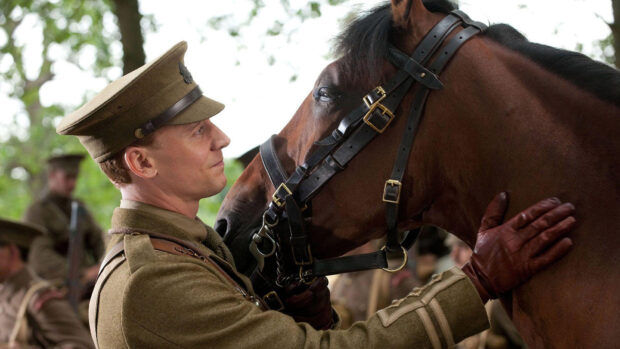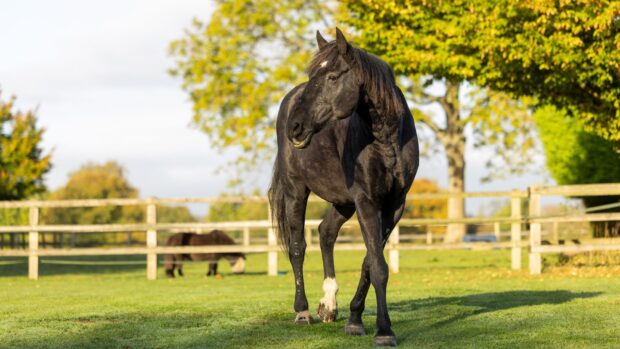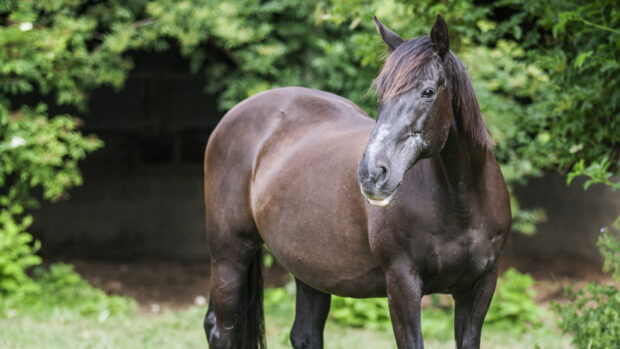Horses have a long standing role in our armed forces and, while they are no longer found on the battlefield, their appearance at state events and shows here and abroad is an iconic part of British military heritage. Music is another key part of that heritage, and the Band of the Household Cavalry, comprised of musicians from The Royal Corps of Army Music, is perhaps the most well known union of military horses and music.
It was formed in 2014 by the union of The Band of The Life Guards with The Band of the Blues and Royals, the two mounted bands of the British Army. With over 60 musicians, it is the largest regular military band in the UK. Based in Windsor, its main tasks include Changing of the Guard at Windsor Castle and performing for The King’s Birthday Parade.
The Band of the Household Cavalry: the drum horses
Perhaps one of the most familiar and loved sights in the Band of the Household Cavalry is the drum horse, with its vast kettledrums, magnificent banners and imposing stature. These horses take part in ceremonial occasions carrying two solid silver kettledrums, personally presented to the Royal Horse Guards in 1805 by King George III as testimony to their honourable and military conduct on all occasions.
Drum horses hold the rank of major, making them the most senior animals in the Army, and can trace their origins back to the Life Guards, formed in 1659 at the Court of the exiled King Charles II in Holland. Size, stamina and temperament are key when it comes to choosing drum horses.
Everything is done in walk for the drum horses, with the rider operating the reins from the stirrups, and the horse must be capable of carrying an adult in ceremonial gear, along with two, 25kg solid silver drums, as well as coping with the noise of crowds. Training takes years, as the horses are taught to cope with the demands of the role and assessed on their confidence to stand out in front of their band on their own.
Traditionally, they are usually a heavy horse breed (part-bred Shire or Clydesdale) and are purchased as four or five year olds. They have also all been geldings until the purchase of the 18.3hh mare Willa Rose in 2021.
Huw Murphy, of Dyfed Shire Horse Farm in Pembrokeshire, and breeder of Willa Rose, first supplied a drum horse to the Household Cavalry in 2008.
“That horse became Mercury, and he served for a decade before returning home to the farm before his death in 2021,” says Huw. “We had a visit from the [then] Prince of Wales and Camilla, Duchess of Cornwall, in 2018 and one of our horses, Red, took Camilla for a cart ride round the farm – he must have impressed her because the Household Cavalry purchased him in 2019!”
Red’s official name is Apollo and Huw says he is highly rated as a drum horse. When the Household Cavalry Riding Master next returned to Dyfed Shire Horse Farm, it was the temperament, stature and presence of homebred Willa Rose that caught his eye during a beach ride.
“She’s making great progress and we’re hoping she will out on ceremonial duties soon,” says Huw.
Once passed as suitable, the drum horses receive their official name from the monarch. A selection of names are sent for the monarch to choose from, and are usually based on battle honours, or characters from ancient/classical history – previous names chosen include Pompeii, Perseus and Cicero; the latter was bought by the Household Cavalry after The late Queen saw him pulling a milk float in Scotland.
The Band of the Household Cavalry: state trumpeters
Also familiar at ceremonial events are the elegant grey horses of the state trumpeters. Always grey, a colour chosen to help mark them out in the chaos of a battlefield where the trumpeters would have communicated orders, trumpeter horses, like their black counterparts in the Household Cavalry, are usually at least 16.2hh and have traditionally come from Ireland.

State trumpeters perform at high profile events such as royal weddings and the State Opening of Parliament, and the musicians are drawn from all ranks of the Band of the Household Cavalry. All have joined The Royal Corps of Army Music and attended riding school before being selected for the role, where they are expected to memorise up to 22 different fanfares.
Their distinctive state dress of gold coat and blue jockey caps is only worn when senior royalty are present. This state dress is the oldest continually worn uniform in the British Army, purchased by the Lord Mayor of London for the restoration of King Charles II in 1660.
You might also be interested in:
The ride on Holkham beach is one of the highlights of the Household Cavalry Mounted Regiment’s annual north Norfolk training

The Household Cavalry: its history, the regiments and the famous Cavalry Black horses

From mud monsters to fit for The King: Army horses return to London after Christmas break

Household Cavalry enjoy a blast on Holkham beach

Subscribe to Horse & Hound magazine today – and enjoy unlimited website access all year round
Horse & Hound magazine, out every Thursday, is packed with all the latest news and reports, as well as interviews, specials, nostalgia, vet and training advice. Find how you can enjoy the magazine delivered to your door every week, plus options to upgrade your subscription to access our online service that brings you breaking news and reports as well as other benefits.




